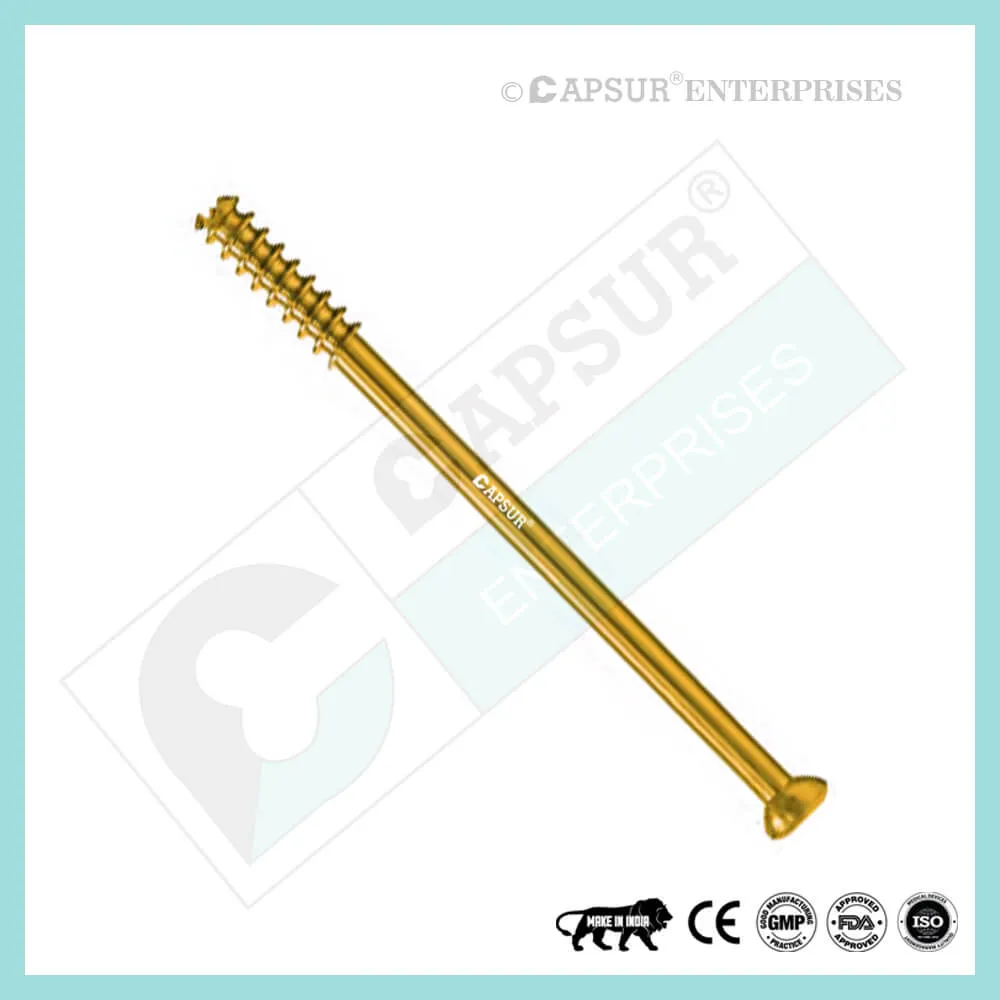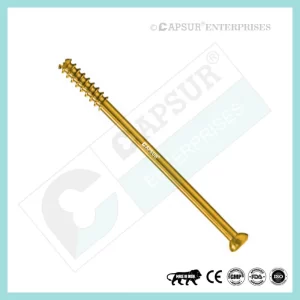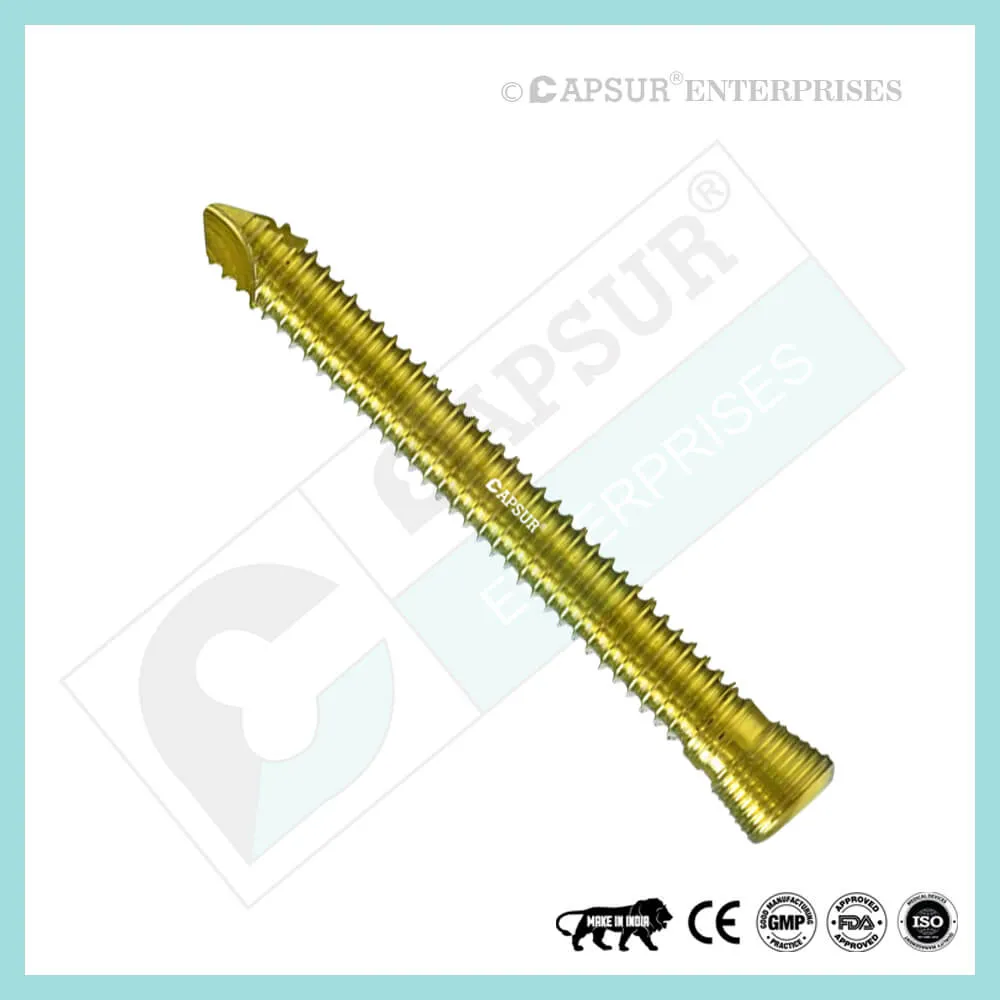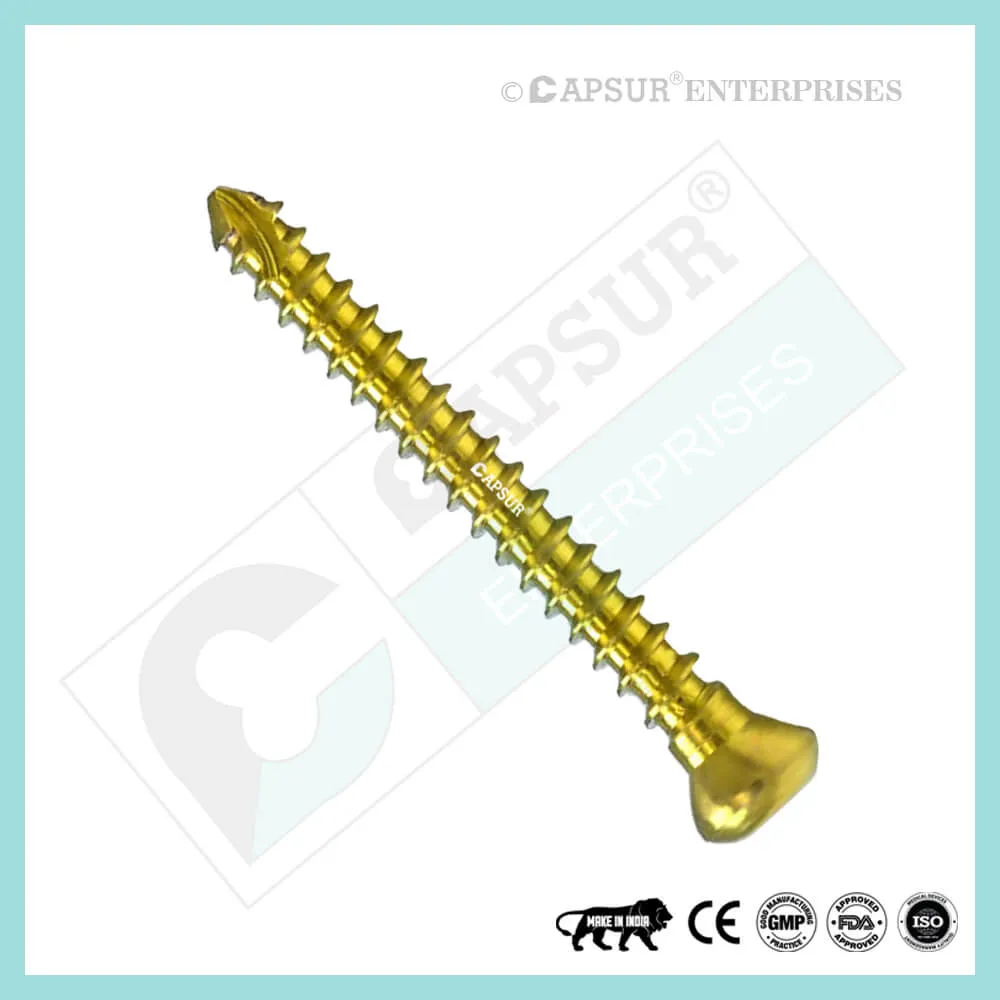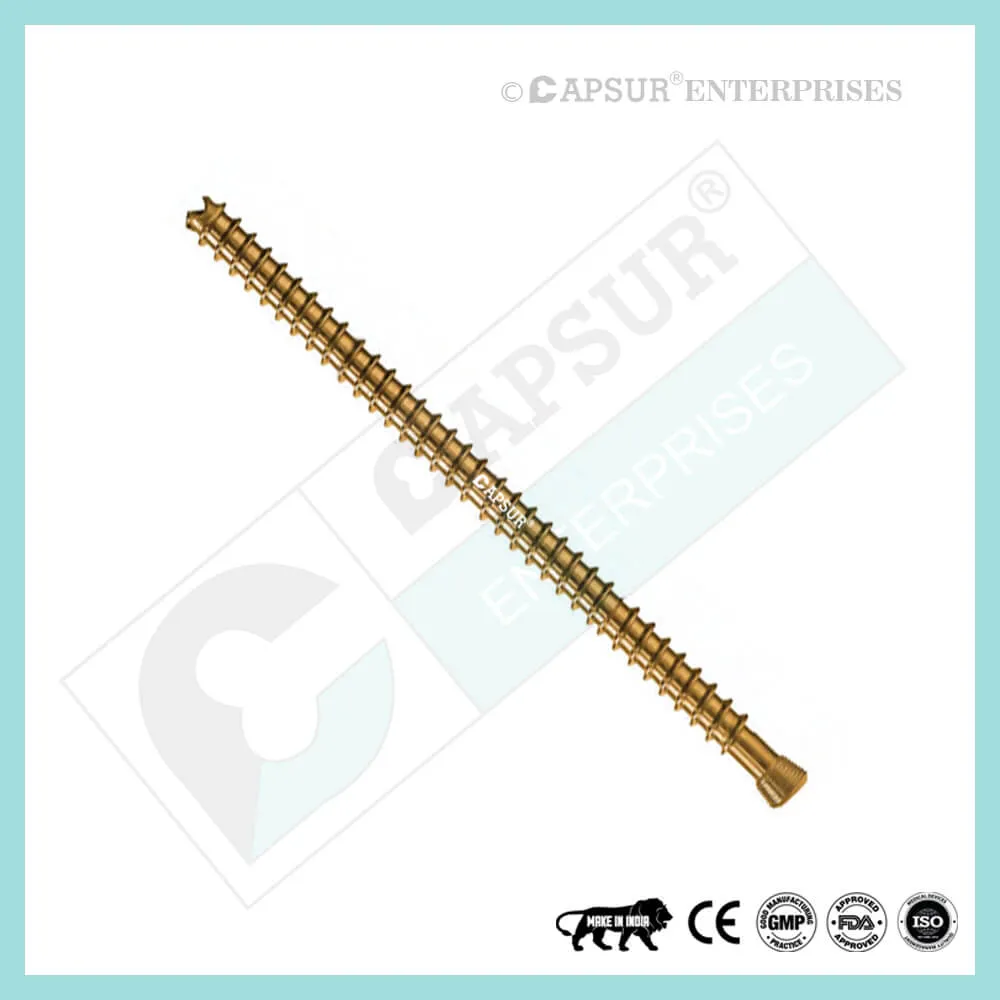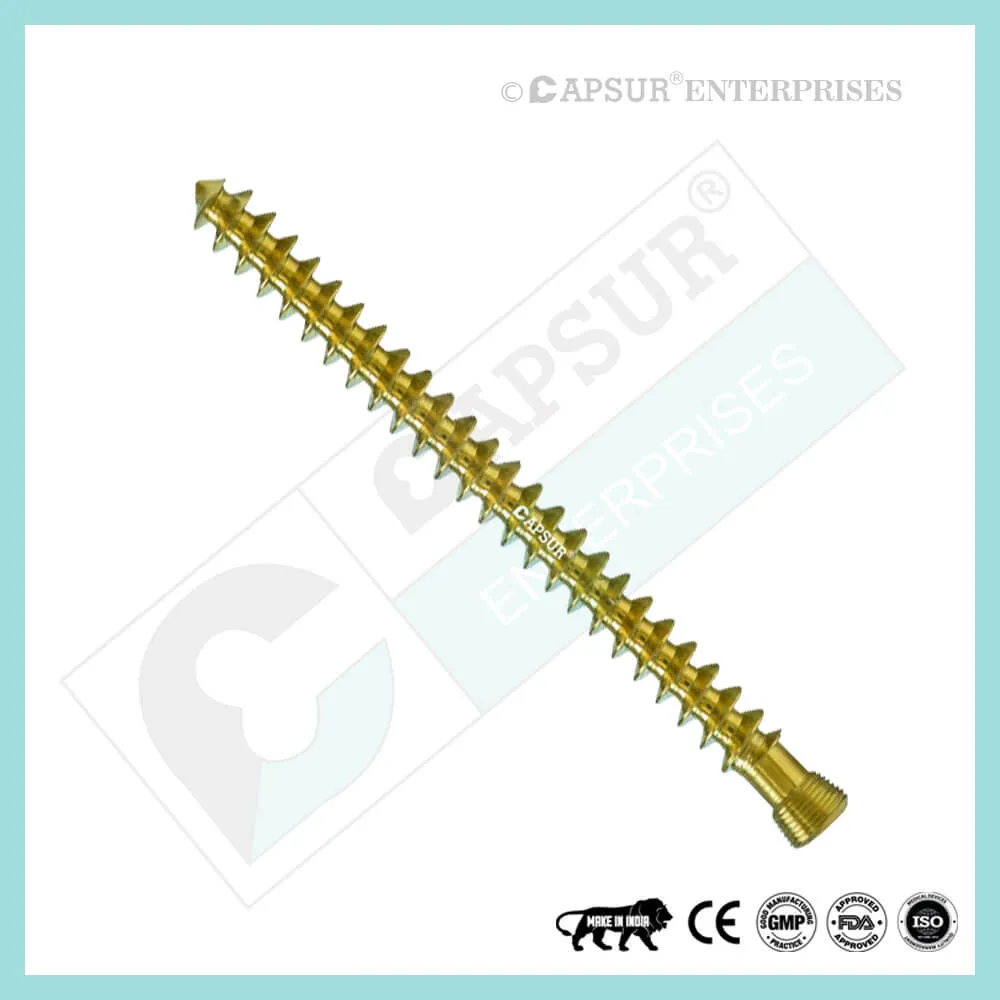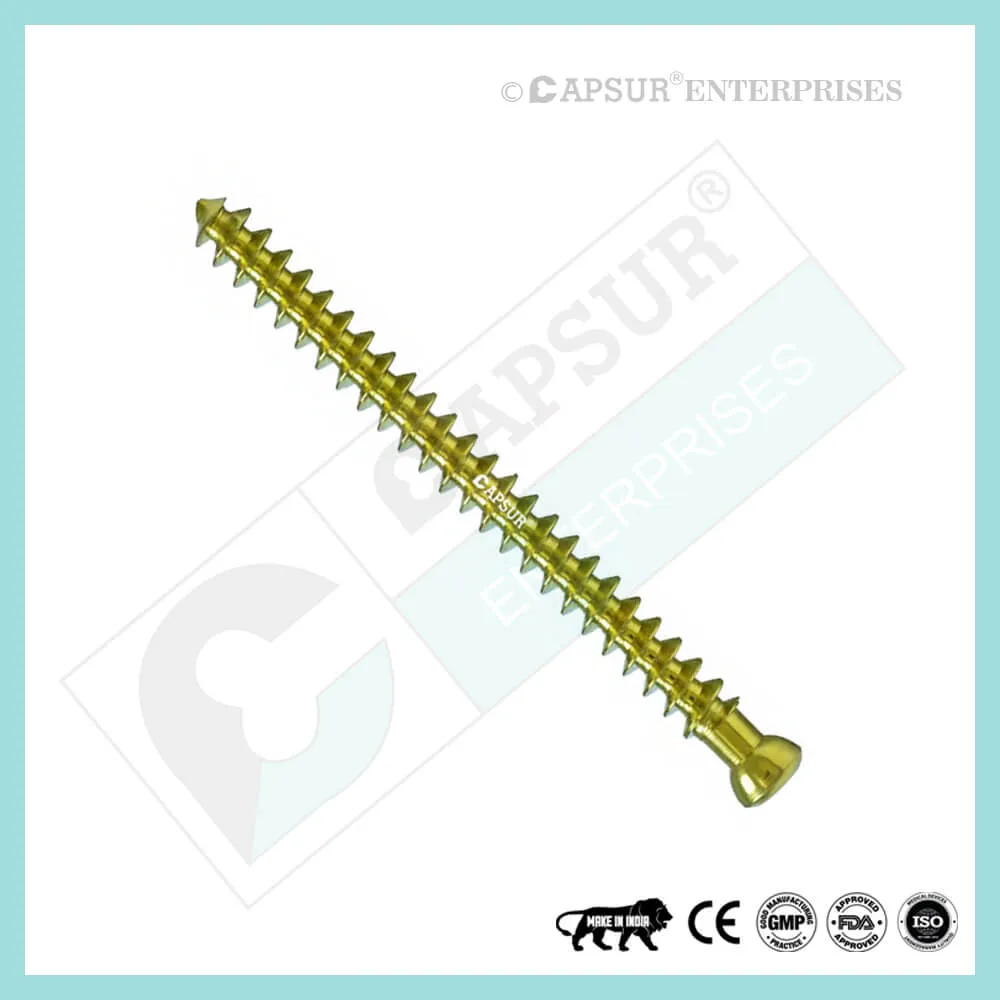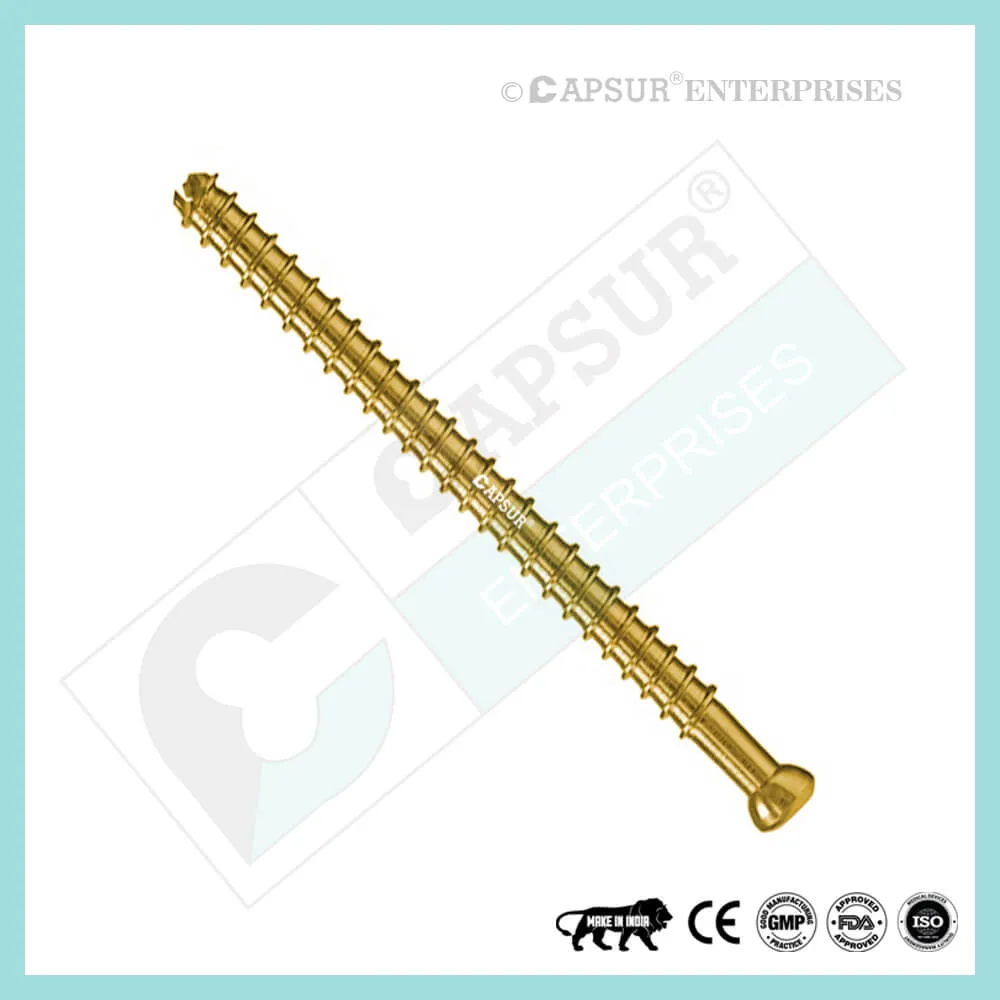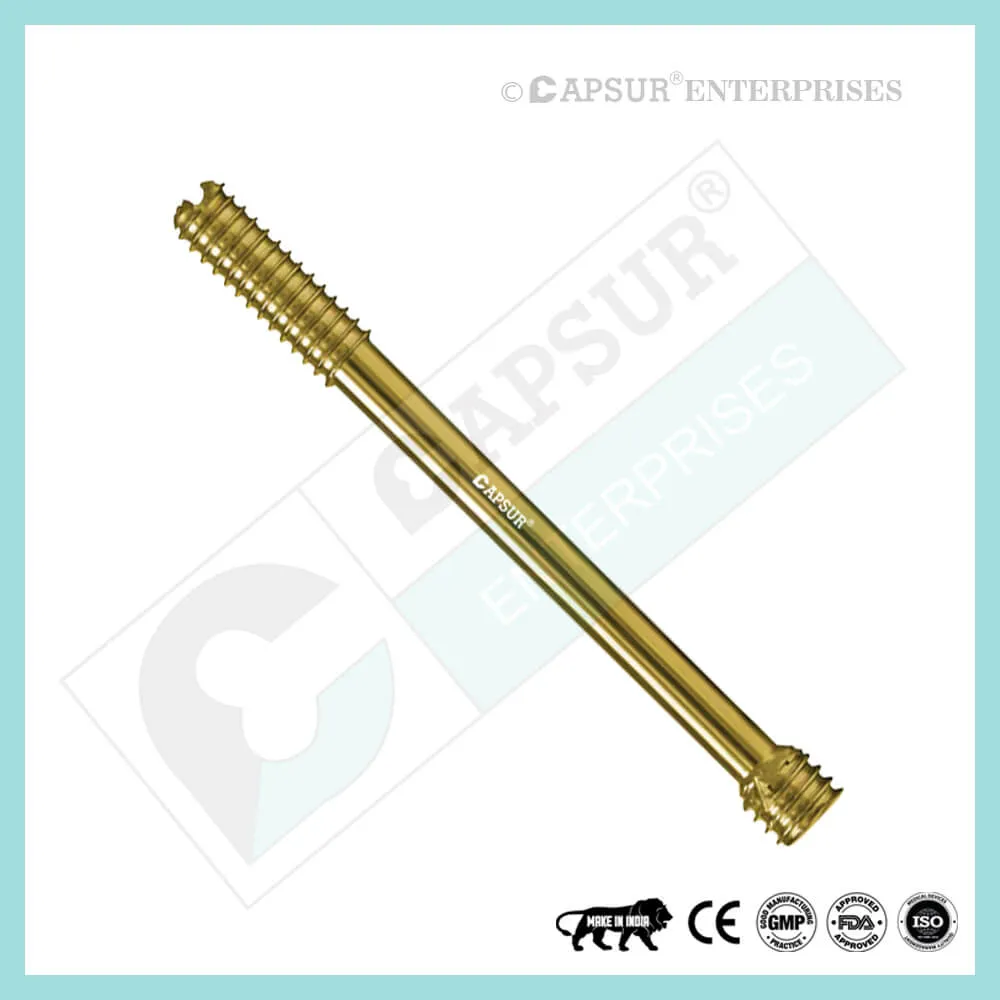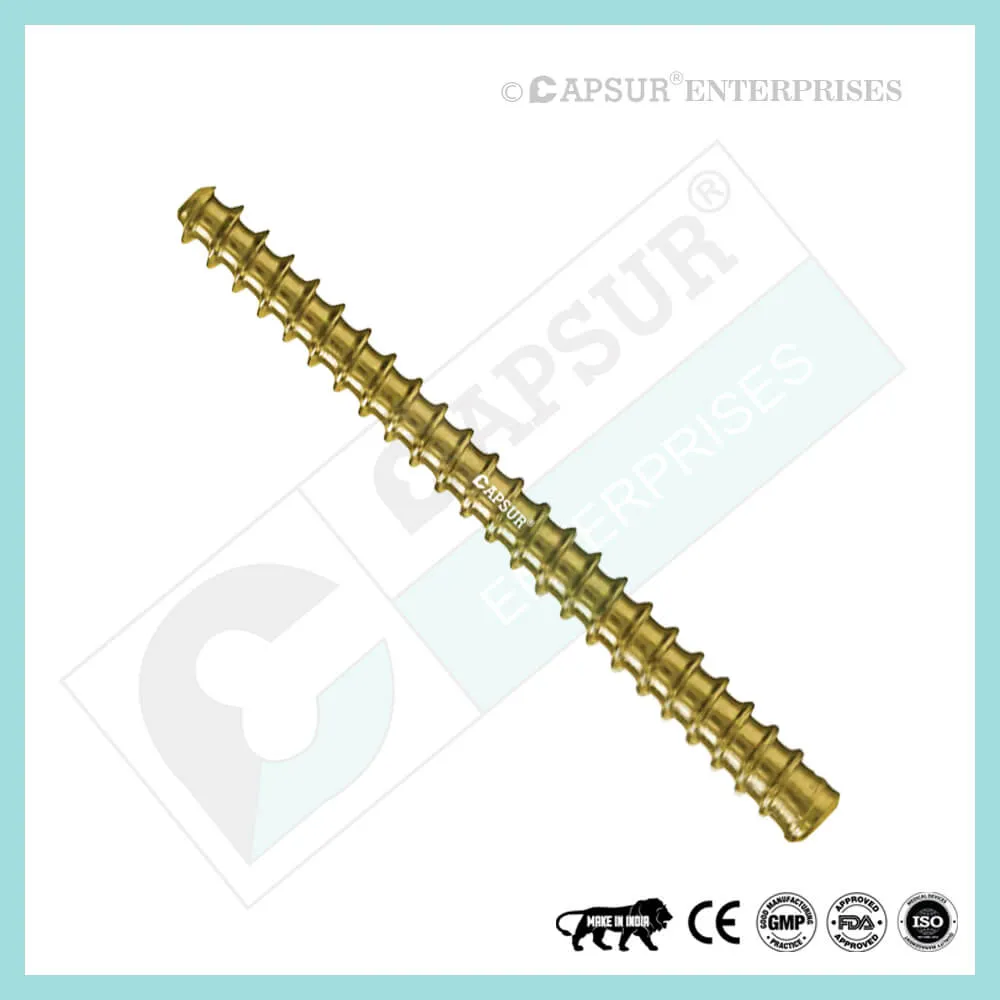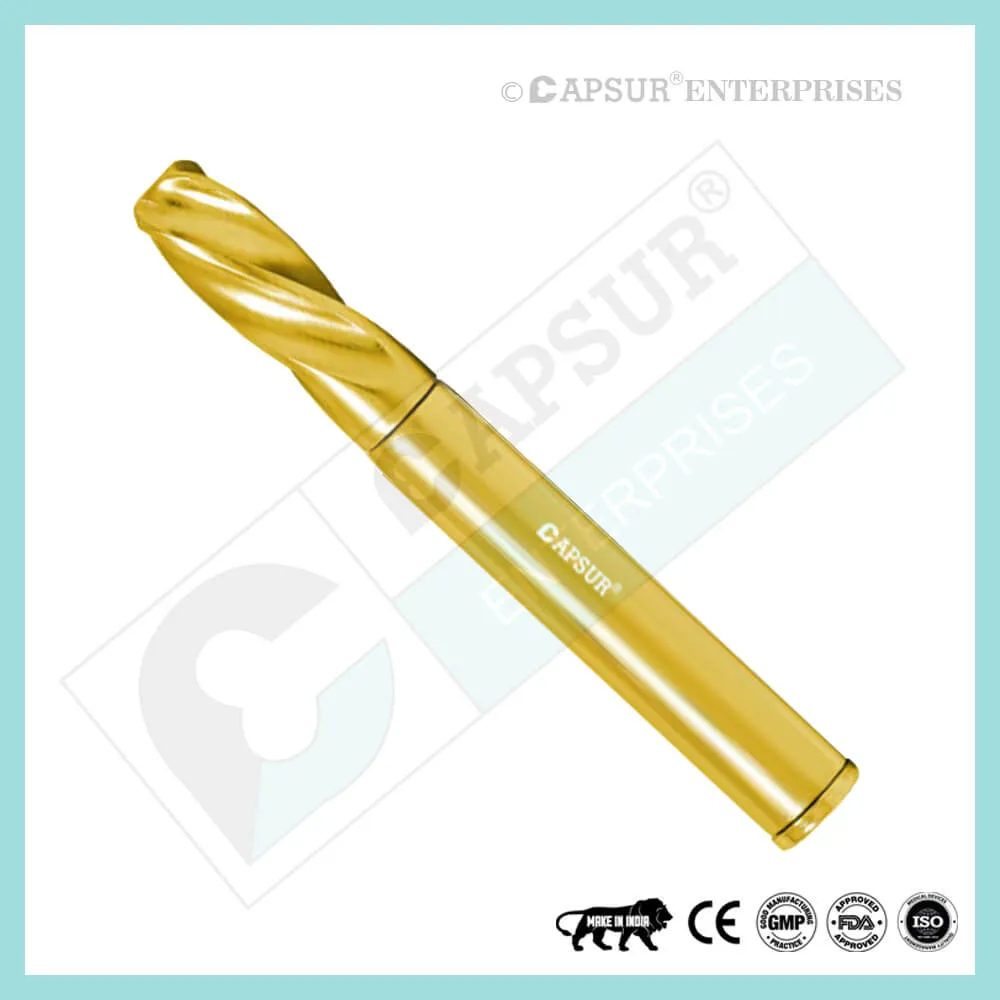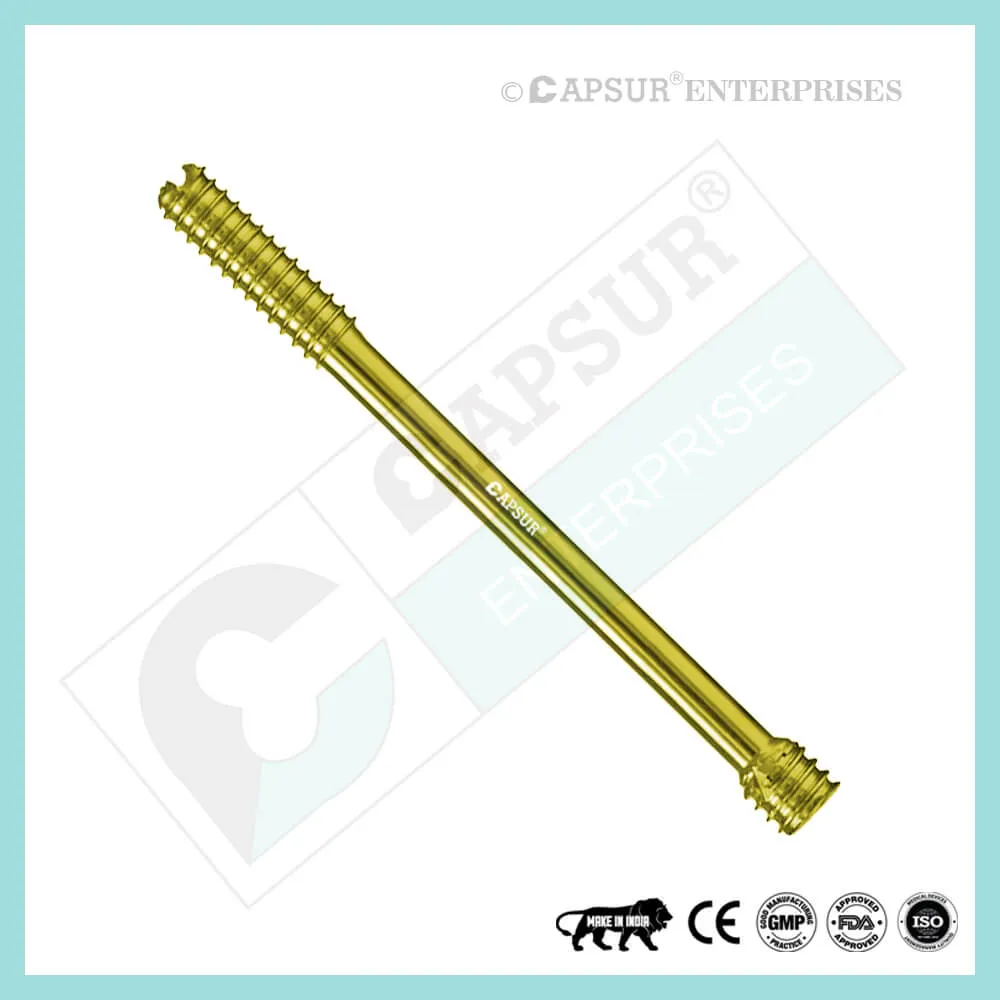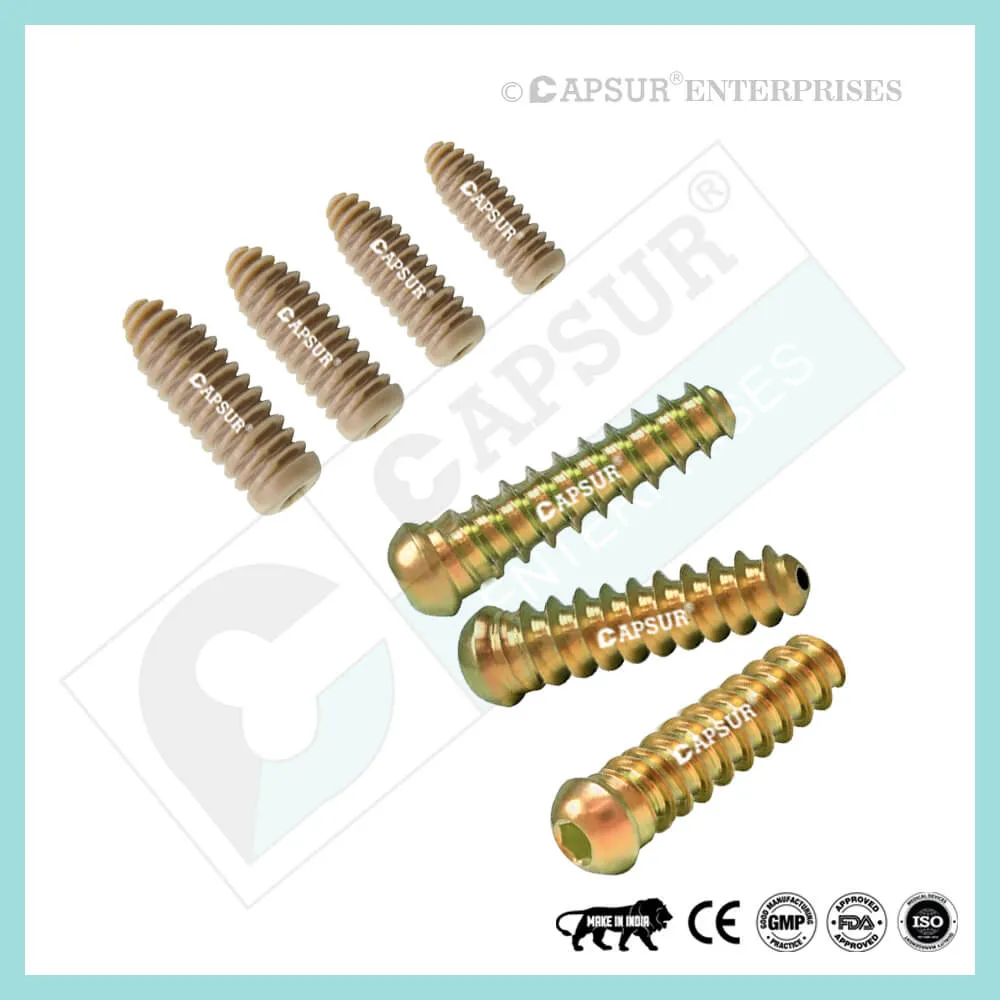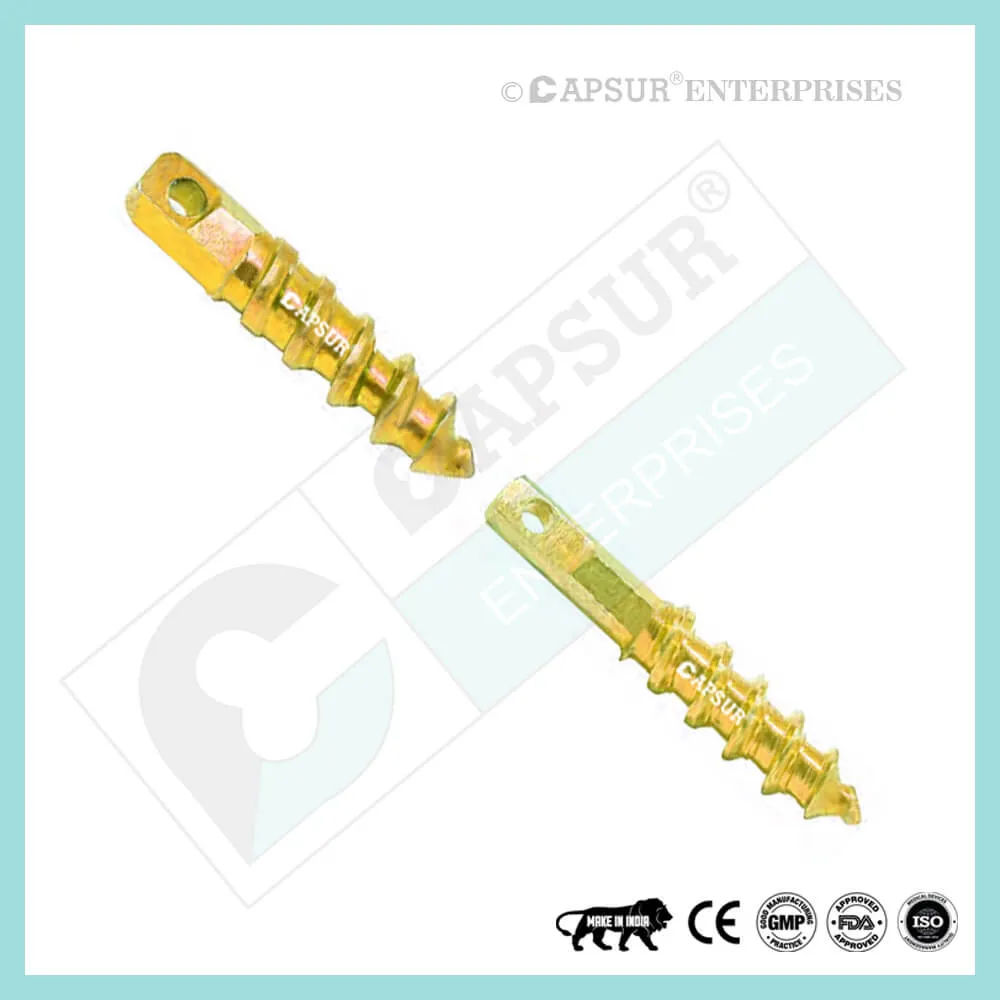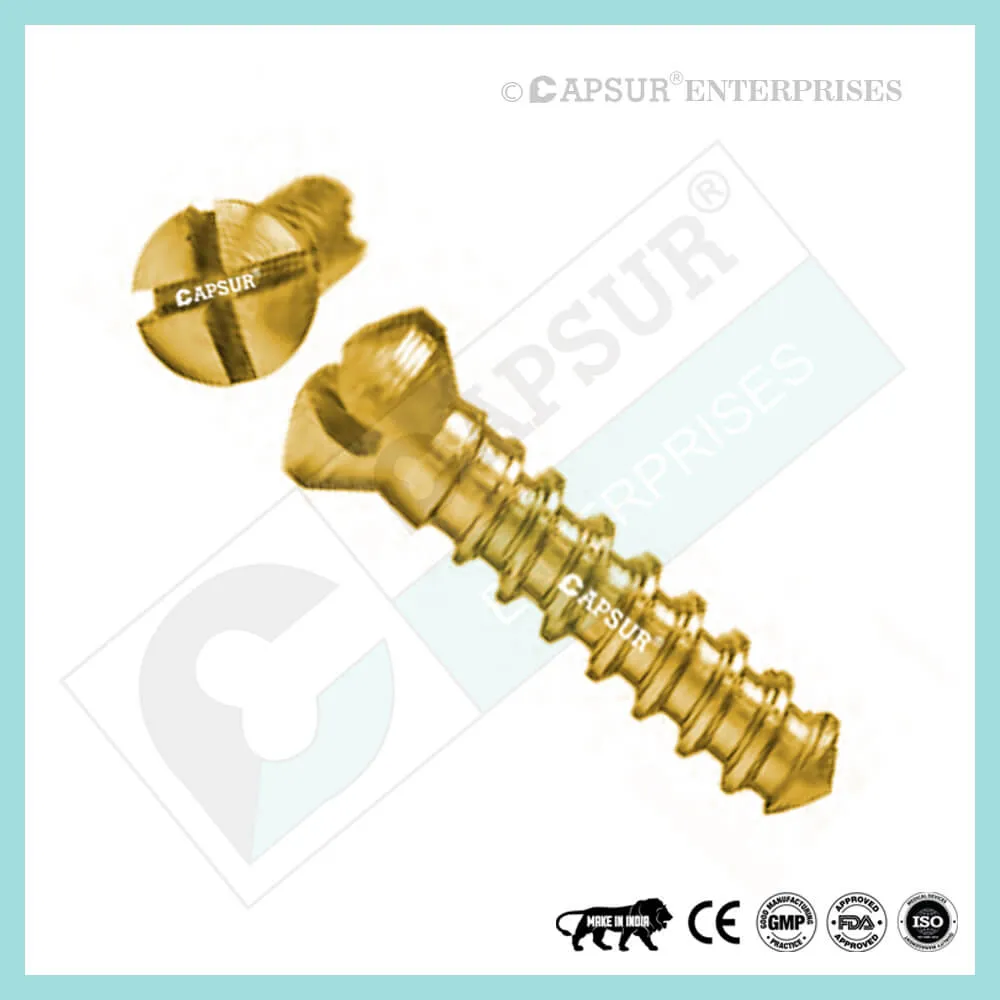Model No: 124433-A12
Description: Lorem Ipsum is not simply random text.
- SUPERIOR QUALITY
- AFFORDABLE PRICING
- TIMELY SHIPMENT
- CUSTOMER SATISFACTION
Specification for 4.5 mm Cannulated Screws, Short Thread
4.5 mm Cannulated Screw available lengths are 20mm, 22mm, 24mm, 26mm, 28mm, 30mm, 32mm, 34mm, 36mm, 38mm, 40mm, 45mm, 50mm, 55mm, 60mm, 65mm, 70mm, 75mm and 80mm
The thread on a 4.5 mm cannulated screw is cancellous. Deep cutting threads with a large pitch are used in cancellous thread profiles to increase pullout resistance. Additionally, a large pitch speeds up screw insertion and removal.
Pure Titanium and SS 316L are used to make the 4.5 mm cannulated screw.
This screw can be made in any additional lengths upon request.
For greater interfragmentary compression, the choice of thread lengths offers the best fit of threads into distant bone fragments.
Flutes with a reverse cutting action help remove screws.
This screw is self-tapping. While being inserted into the bone, self-tapping screws cut their own thread. When it enters the bone, it makes a tiny hole that forces the threads together tightly. This prevents vibration-induced loosening and makes it possible to disassemble the parts if necessary.
Tools like Bone Taps, Combined Drill & Tap Sleeve, Counter Sink, Depth Gauge, Drill Bits, Drill Guide, Drill Sleeve, Hollow Mill Screw Removal, Reverse Measuring Device, Screw Drivers, Screw Holding Forceps, etc. are available for this screw.
Uses of 4.5 mm Cannulated Screws, Short Thread
- The 4.5 mm Cannulated Screw is designed to fix small and large bone fractures, fusions, and osteotomies that are appropriate for the device’s size.
- A central shaft that is hollow is a cannulated screw. Cannulation is an option for cortical and cancellous screws. For the fixation of diaphyseal fractures, lag screws made of both cannulated and noncannulated cortical screws are used instead of cannulated cancellous screws.
- By capturing the bone fragment in the screw’s threads and pulling it toward the nearby cortex fragment on the screw’s head side, partially threaded screws can be used to lag one bone fragment to another. Fully threaded screws are designed to be used in situations where there is little to no compression across the fracture in order to stabilize it.
- Cannulated screw systems offer excellent stability, percutaneous screw fixation, and emergency closed reduction.
- In comparison to conventional screws, cannulated bone screws shorten surgery time, enable more accurate screw placement, and lower the risk of mistakes.
- The Knowles pin, a cannulated screw used to fixate slipped capital femoral epiphysis in children, is one special type of cannulated cancellous screw.
Other Useful Info of 4.5 mm Cannulated Screws, Short Thread
Different Types of Screws including 3.5 mm Locking Cancellous Screw
Locking Cortical Screws
- 2 mm Locking Cortical Screws
- 2.4 mm Locking Cortical Screws
- 2.7 mm Locking Cortical Screws
- 3.5 mm Locking Cortical Screws
- 5 mm Locking Cortical Screws
Cortical Screws
- 1.5 mm Cortical Screws
- 2 mm Cortical Screws
- 2.4 mm Cortical Screws
- 2.7 mm Cortical Screws
- 3.5 mm Cortical Screws
- 4.5 mm Cortical Screws
Locking Cancellous Screws
- 3.5 mm Locking Cancellous Screw
- 4 mm Locking Cancellous Screw
- 5 mm Locking Cancellous Screw
- 6.5 mm Locking Cancellous Screw
Cancellous Screws
- 3.5 mm Cancellous Screw
- 4 mm Cancellous Screw
- 6.5 mm Cancellous Screw
Locking Cannulated Screws
- 4 mm Locking Cannulated Screw
- 5 mm Locking Cannulated Screw
- 6.5 mm Locking Cannulated Cancellous Screw
- 7.3 mm Locking Cannulated Cancellous Screw
Cannulated Screws
- 3.5 mm Cannulated Screws (Cortical Thread)
- 4 mm Cannulated Cancellous Screws
- 4.5 mm Cannulated Cancellous Screws
- 6.5 mm Cannulated Cancellous Screws
- 7 mm Cannulated Cancellous Screws
- 7.3 mm Cannulated Cancellous Screws
Headless Screws Full Thread
- 2.5 mm Headless Compression Screws Full Thread
- 3 mm Headless Compression Screws Full Thread
- 3.5 mm Headless Compression Screws Full Thread
- 4 mm Headless Compression Screws Full Thread
- 4.5 mm Headless Compression Screws Full Thread
- 5 mm Headless Compression Screws Full Thread
- 5.5 mm Headless Compression Screws Full Thread
- 6.5 mm Headless Compression Screws Full Thread
Headless Screws Partially Thread
- 2.5 mm Headless Compression Screws Partially Thread
- 3 mm Headless Compression Screws Partially Thread
- 3.5 mm Headless Compression Screws Partially Thread
- 4 mm Headless Compression Screws Partially Thread
- 4.5 mm Headless Compression Screws Partially Thread
- 5.5 mm Headless Compression Screws Partially Thread
- 6.5 mm Headless Compression Screws Partially Thread
- 7.5 mm Headless Compression Screw Partially Thread
Interlocking Nail Screws
PFNA2 Blades
PFNA Blades
- 8 mm Proximal Cannulated Bolt
- 6.4 mm Proximal Cannulated Bolt
- 4.9 mm Locking Bolts
- 3.9 mm Locking Bolts
- 3.4 mm Locking Bolts
Interference Screws
- 5 mm Interference Screw
- 6 mm Interference Screw
- 7 mm Interference Screw
- 8 mm Interference Screw
- 9 mm Interference Screw
- 10 mm Interference Screw
Herbert Screws
- 2.5 mm Cannulated Herbert Screws
- 3 mm Cannulated Herbert Screws
- 3.5 mm Cannulated Herbert Screws
- 4.5 mm Cannulated Herbert Screws
- 5.5 mm Cannulated Herbert Screws
- 6.5 mm Cannulated Herbert Screws
Craniomaxillofacial Screws
- 1.5 mm Screw Craniomaxillofacial
- 2 mm Screw Craniomaxillofacial
- 2 mm Locking Screw Craniomaxillofacial
- 2.5 mm Screw Craniomaxillofacial
- 2.5 mm Locking Screw Craniomaxillofacial
- 2.8 mm Screw Craniomaxillofacial
- 2.8 mm Locking Screw Craniomaxillofacial
- 2.7 mm Emergency Screw
Malleolar Screws
- 3.5 mm Malleolar Screws
- 4.5 mm Malleolar Screws
The most frequently used orthopedic implants are bone screws. For various types of bones, there are numerous types and sizes of screws. The majority of bone screws are constructed from titanium or stainless steel alloys. When determining screw mechanics, it’s important to consider the outer diameter, root diameter, thread pitch, and angle.
A “3.5 mm Locking Cancellous Screw” is a common way to refer to a screw in orthopedics that has an outside diameter of 3.5 mm. The linear distance covered by a screw during one complete turn is known as the pitch of the screw. With each full turn, the screw moves forward by a distance equal to the space between the threads. Cortical screws have more threads because they have a lower pitch. Given the fragility of the bone, cancellous bone screws have a deeper screw to increase surface area and enhance purchase.
Screws work by converting the torque applied to tighten them into internal tension and elastic responses in the bone around them. The fracture fragments that the screw is holding together are compressed as a result. Typically, screws are inserted into holes that have been drilled to the same diameter as the root and are either self-tapping or have been tapped (threaded) beforehand. The screws must be properly inserted into the proper size drilled hole and made to withstand the insertion torque levels anticipated in cortical bone because the torque to insert cortical bone screws can be high. Large, deep threads on cancellous bone screws allow them to securely hold the spongy bone. It is uncommon for a screw to fail during insertion due to the cancellous bone’s relatively low strength, but pull out can be problematic.
3.5 mm Locking Cancellous Screw Risk Factor
Ontraindications may be partial or complete, and they must be taken into account when determining the prognosis in each situation. Under the following circumstances, alternative management strategies may need to be taken into account:
- infections that are systemic or local, acute or chronic.
- either localized, systemic, or chronic inflammation.
- serve as a dangerous vascular, nervous, or muscular disease.
- Bone defects that would prevent the implant from being properly anchored.
- All associated illnesses that might jeopardize the implant’s success and functionality.
Warnings and Precautionary for 3.5 mm Locking Cancellous Screw
Before using the 3.5 mm Locking Cancellous Screw, the surgeon and support personnel should read the safety instructions as well as any information specific to the product in the product description, surgical instructions, and/or brochures.
Screws are carefully designed, built, and produced using materials of the highest quality for medical use. If used properly, these high-quality screws guarantee the best working outcomes. The usage guidelines and safety advice that are provided below must be followed.
Incorrect screw usage can result in tissue damage, premature wear, instrument destruction, injury to the operator, patients, or other people, and injury to the tissue.
It is essential that the operating surgeon actively participate in the medical care of their patients. All facets of the surgical procedure and the tools used, including their limitations, should be fully understood by the surgeon. It is the surgeon’s and the surgical team’s responsibility to take care in the selection and use of surgical instruments. Prior to using implants, sufficient surgical training must be obtained.
The following variables could harm the operation’s success:
- implanted material allergies.
- specific bone tumors.
- both osteoporosis and osteomalacia.
- disordered metabolism and systemic disease.
- abuse of drugs and alcohol.
- The implant is exposed to blows and/or excessive loading during physical activities that involve strong shocks.
- Patients who are mentally incapable of understanding and following instructions from the doctor.
- unhealthy in general.
- Effects that could be harmful
The most frequent side effects of implantation are the ones listed below:
- cyclic loading of the fixation site and/or an implant’s response to tissue can both lead to screw loosening.
- infection both early and late.
- additional bone fracture brought on by unusual stress or weakening of the bone matrix.
- pressure or hematoma-induced temporary or permanent neural damage.
- Hemorrhages and slow wound healing.
- Heart arrest, pulmonary embolism, and venal thrombosis are examples of vascular disease.
- Ossification that is heterotopic.
- Due to the 3.5 mm Locking Cancellous Screw, there is pain and discomfort.
- Failure due to mechanical forces, such as bending, loosening, or breakage of the implant.
- Implant migration that causes harm.
Preoperative Planning for 3.5 mm Locking Cancellous Screw
A thorough clinical evaluation of the patient is followed by the execution of the operating plan. X-rays are also required to provide a clear picture of the bony anatomy and any associated deformities. A complete size of 3.5 mm Locking Cancellous Screw and the appropriate implantation tools must be on hand at the time of the procedure.
The patient should be informed of any potential risks and side effects related to implant use by the clinician. It is critical to ascertain the patient’s allergy status to all implant materials prior to surgery. The patient must also be made aware that the device’s performance cannot be guaranteed because problems may shorten the device’s useful life.
3.5 mm Locking Cancellous Screw Precautions
During reprocessing, verify that the instruments are functional and look for wear. Before using, replace any worn-out or broken instruments.
It is advised to use the tools designated for this screw.
Use caution when handling equipment, and put used bone-cutting tools in a sharps container.
Always use suction and irrigation to remove any debris that may be produced during implantation or removal.
3.5 mm Locking Cancellous Screw Warnings
Locking 3.5 mm Cancellous During use, a screw may break (if excessive forces are applied). We advise that the broken part be removed whenever possible and practical for the particular patient, though the surgeon will ultimately decide whether to do so based on the risk involved. Be aware that implants lack the natural bone’s strength. Significant loads may cause implants to fail.
The user’s glove or skin may be pinched or torn by the sharp edges or moving joints of some instruments, screws, and cut plates.
Be sure to get rid of any fragments that weren’t fixed during surgery.
While the surgeon will ultimately decide whether to remove the implant, we advise that fixation devices be taken out as soon as it is safe and practical for the specific patient and after their purpose as a healing aid has been fulfilled. To prevent refracture, implant removal should be followed by adequate post-operative care.
3.5 mm Locking Cancellous Screw General Adverse Events
There are risks, side effects, and adverse events associated with all major surgical procedures. While there are many possible reactions, the following are some of the most frequent ones: issues related to anesthesia and patient positioning (such as nausea, vomiting, dental injuries, neurological impairments, etc.), thrombosis, embolism, infection, damage to nerve and/or tooth roots or other critical structures, such as blood vessels, excessive bleeding, damage to soft tissues, including swelling, abnormal scar formation, functional impairment of the musculoskeletal system, and pain.
| 4.5 mm Cannulated Screws, Short Thread |
|---|


